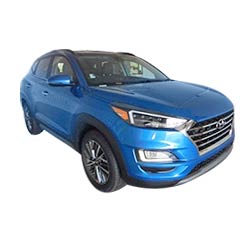2020 Hyundai Tucson Trim Levels with Comparisons & Configurations.
Part way into into its third generation, the Hyundai Tuscon firmly retains its place as one of the best small SUVs on the market. The 2020 Hyundai Tuscon has a few flaws, sure, but they are ones that can be looked past. Avoid the base engine and plan on spending a little more at the pump; other than this, you will probably find a lot of things that you enjoy about this vehicle.
First, it gives you a huge amount of standard features for the cost. And, when it comes to infotainment features, Hyundai nails them, giving you easy-to-access features that don't malfunction and cause distracted driving. You also get a nice, cozy ride quality out of this SUV. Finally, the interior design looks really upscale - more so than what you might expect from a non-luxury vehicle.
So, which of the 2020 Hyundai Tuscon's seven trim levels is the right one for you? Could it be the base SE? How about the Sport? Or are you looking for the utmost in creature comforts, which the Ultimate can provide? This trim level comparison review will help answer your questions. By the end of this review, we will declare which trim level will give the average driver the best overall deal.
Compare the 2020 Hyundai Tucson SE vs Value Trims. What is the difference?
To kick things off, we have the 2020 Hyundai Tuscon's base trim level, the SE, and the second trim level up, the Value. Both of these trim levels are powered by a 2.0-L 4-cylinder engine, which generates 161 hp and 150 lb-ft of torque. Front-wheel drive comes standard, but all-wheel drive is optional on every trim level. Also, a 6-speed automatic transmission gets paired up with every engine option in the line-up. This engine nets these trim levels 23 mpg in the city, 30 mpg on the highway, and a combined 26 mpg on the front-wheel drive variants. On all-wheel drive, they get 22 mpg in the city, 25 mpg on the highway, and a combined 23.
These five-seater small SUVs both have a towing capacity of 1,500 pounds, which is pretty much on par for their segment. Other mechanical features that come standasrd on the SE and Value trim levels include independent MacPherson struts up front, an independent multi-link rear suspension, and 17-inch alloy wheels. On the whole, these two trim levels show no real mechanical differences.
On the exterior, these trim levels share projector headlights that are automatic, a roof-mounted center high mount stop light, power-folding body-colored side mirrors, body-colored door handles, solar glass, privacy glass on the rear, and a shark fin roof antenna. The Value gives you a few additional standard features, such as roof side rails, heated side mirrors, and LED daytime running lights.
Their interiors are somewhat similar as well. Cloth seats are the standard, and there is YES Essentials grey and beige cloth material. The driver's seat is power-adjustable six different ways, and the 60/40-split folding rear seats have a reclining function for additional comfort. The dual-level cargo floor allows for a more versatile storage area, and manual air conditioning also comes equipped.
Apple CarPlay and Android Auto come equipped and allow you to sync your smartphone app's with the vehicle's infotainment system. On the SE, there is a 7-inch color touchscreen display with a 6-speaker sound system. The Value trim level gets SiriusXM and HD Radio added into the mix. Front auxiliary and USB outlets come standard, as do a rearview monitor, tilt and telescoping steering wheel with multiple controls mounted onto it, a 3.5-inch multi-information display, power windows (with automatic down on the driver's window), remote keyless entry, power door locks, two 12-volt outlets up front and one in the cargo area, and a proximity key entry feature with push button start.
The Value trim level does get a few important upgrades. First, there is the driver's seat, which becomes 8-way power-adjustable. The front seats also get standard heating, which feels amazing when the weather is cool. The Blue Link Connected Car system also comes standard. This system gathers vehicle information and has features like SOS emergency assistance, maintenance alert, and automated collision assistance and notification.
Speaking of safety, the Tuscon's two lowest trim levels are remarkably well-equipped with standard safety features. Both trim levels have driver attention warning, lane keep assist, forward collision avoidance assistance, an anti-theft system, rear child safety locks, and a tire pressure monitoring system. The Value, of course, gets a few more desirable safety features. It is equipped with blind spot monitoring and rear cross traffic collision warning.
Overall, the SE trim has a good amount of standard equipment, but the Value gives you exponentially more for just a little over $1,000. The Value trim indeed lives up to its name.
Compare the 2020 Hyundai Tucson Value vs SEL Trims. What is the difference?
The next level up is the SEL. This trim level has some noteworthy differences, the first of them - and the most obvious once you start driving it - is the engine. The SEL (and all above trim levels) gets a 2.4-L inline-4 cylinder engine that is capable of generating 181 hp and 175 lb-ft of torque. While the transmission and drivetrain options remain the same, the towing capacity gets boosted to 2,000 pounds. Also, it gets bigger 18-inch alloy wheels.
On the outside, the SEL gets a few important alterations. It gains premium front and rear fascias and side sills which serve to make the SEL look a little bit more posh on the exterior. Otherwise, you should expect most of the Value's great features to remain on the SEL. The cabin is mostly the same, too, save for the addition of a USB outlet in the second row, a dual-zone automatic climate control system, and rear A/C vents mounted on the floor console.
All of the safety features that come on the Value trim also come on the SEL. Choosing between the Value and SEL will come down to how much more power you want from the vehicle's engine. If you crave a swift acceleration, then the SEL's 2.4-L engine is the better choice for you.
Compare the 2020 Hyundai Tucson SEL vs Sport Trims. What is the difference?
Looking for something a little sporty? Well, then the Tuscon's Sport trim might be of interest. It prices about $2,000 above the SEL trim and has the same set-up under the hood. However, the wheels are upgraded to 19-inch Sport wheels done in alloy.
The body has some noteworthy changes. The projector headlights get dumped in favor of LED headlights and taillights. LED daytime running lights and front fog lights also come standard. There is also a hands-free smart liftgate that has automatic opening and an adjustable height setting.
A lot of interior features are also the same, but there are a few stark contrasts. The biggest is the Infinity Audio System, which has Clari-Fi music restoration technology. It also has 8 speakers and an external amplifier. Wireless device charging is also available.
Compare the 2020 Hyundai Tucson Sport vs Limited Trims. What is the difference?
The Limited trim level is close to topping the line-up and does slap on some additional features that make it worth the $2,000 price jump up from the Sport trim. The engine is the same, but it gets the same 18-inch alloy wheels that can be found on the SEL trim level.
Many things are the same on the outside, but the Limited gets some additions to what the Sport offers. The Limited gets integrated turn signals on the side mirrors, a chrome accent grille, chrome door handles, and chrome window trim molding. The interior gains lush leather seats, an 8-way power-adjustable passenger seat, and a leather-clad shift knob and steering wheel with heating.
As far as safety features go, the Limited gains a surround-view camera to help you see all areas around the vehicle. Aside from these changes, you will get all the features you find on the Sport trim. Most of the alterations are based on luxury aesthetics.
Compare the 2020 Hyundai Tucson Limited vs Night Trims. What is the difference?
The Night trim level costs a little over a grand more than the Limited, but it does make a few interesting additions. Everything is the same under the hood, but the Night gets 19-inch BBS alloy wheels that are finished in black satin. The exterior is, quite clearly, swathed in black, hence the trim level's name. There are black window sill moldings, a black paint job, black door handles and side mirrors, and unique dual exhaust finishers.
On the inside - you guessed it - you will see more black. While the seats are cloth, the leather-wrapped steering wheel and shift knob has perforation. There are also aluminum alloy sport pedals, and smart cruise control with stop and start.
Compare the 2020 Hyundai Tucson Night vs Ultimate Trims. What is the difference?
Here we are, at the top of the 2020 Hyundai Tuscon line-up. As you can see, the lower trim levels already have a lot of features. So what can the Ultimate possibly add? Well, there are a couple of things that make the Ultimate worth its cost.
First, there the additions of high beam assist, ventilated front seats, and heated second row seats. An 8-inch touchscreen with built-in navigation gets thrown into the standard features mix, as do rain sensing wipers, and a 4.2-inch LCD multi-information instrument gauge panel. Like the Night, it has forward collision avoidance assist, and it has the Limited's surround view camera. Virtually everything else remains the same as what is on the Limited.
Which Trim to Choose?
The 2020 Hyundai Tuscon has a pretty solid line-up. The base trim is decently equipped, but it and the Value are hindered by the laggy 2.0-L 4-cylinder engine. The engine is the real downfall of the line-up, but, thankfully, the 2.4-L makes up for it. But that does mean you have to spend more to get more.
If you do not mind the extra few grand you will have to pay, the SEL is a nice middle-ground between the lower trim levels and the higher ones. It has an abundance of infotainment features and almost all of the safety features that you can get on the Tuscon. The SEL might not be as luxurious as the Limited, Night, or Ultimate, but it is still a fine-looking vehicle all the same. The interior is cozy, and the materials all look to be high quality.
Of course, if you can swing it, the Night is really cool if you prefer all black. The Ultimate is also quite a steal for the price. It actually rivals - and even bests - some small SUVs. But the SEL should be just right for the average driver.
• 2020 Hyundai Accent Trims
• 2020 Hyundai Elantra Trims
• 2020 Hyundai Kona Trims
• 2020 Hyundai Palisade Trims
• 2020 Hyundai Santa Fe Trims
• 2020 Hyundai Sonata Trims
• 2020 Hyundai Sonata Hybrid Trims
• 2020 Hyundai Tucson Trims
• 2020 Hyundai Veloster Trim Configurations


